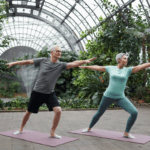Coming Soon: E-book about Kundalini Yoga - Sign up here to be among the first to get it!
Have you ever walked into a yoga class, looked around, and felt like an outsider? You’re not alone. The image of the ‘ideal’ yoga practitioner often portrayed in our society – slim, flexible, affluent – can be disheartening to many who don’t fit this mold. It’s time we confront this elephant in the room: there’s a pressing need for greater diversity inclusion and accessibility in yoga.
This post is about change; it’s about making space where everyone feels welcome regardless of their body type or socioeconomic status. It’s also about tackling power dynamics within the industry that perpetuate exclusionary practices. But how do we begin?
In this post you will discover why current approaches have been ineffective and what new strategies are working better to create inclusive environments — from trauma-informed teaching methods to community collaborations.
Table Of Contents:
- Identifying the Problem of Diversity, Inclusion, and Accessibility in Yoga
- The Ineffectiveness of Current Approaches to Diversity and Inclusion in Yoga
- What Works: Successful Approaches to Diversity, Inclusion, and Accessibility in Yoga
- Fostering Inclusion, Equity, Diversity, and Accessibility in Yoga
- Making Yoga Accessible: Action Items for Change
- FAQs in Relation to Diversity inclusion and Accessibility in Yoga
- Conclusion
Identifying the Problem of Diversity, Inclusion, and Accessibility in Yoga
Diversity issues arise when yoga classes are dominated by a a specific group, demographic, gender type or ethnicity. Particularly, several mainstream yoga channels often promote one body type – slim and athletic, super flexible and capable of achieving very complex poses – leaving those with different bodies and abilities feeling excluded.
The Homogeneity of Yoga Spaces
Current main stream yoga is influenced by the body image of the ’80-’90, celebrating the body building culture and the achievement of perfection in poses through a unique physique. If you like to dive a little deeper on this topic, check out Mark Singleton Book “the Yoga Body”. This is quite far from the ancient and traditional yoga teaching, the yoga sutra never talked about achieving perfect form, rather fostering acceptance of one-selves. It seems that some branches of yoga have been westernised. The mainstream culture has deeply influenced the image we have about who practices yoga. For this reason marginalised groups can potentially feel left out from mainstream yoga studios because these spaces mirror this exclusive perception. As a consequence, these perceptions create power dynamics that discourage diversity within our local community.
In reality, your body type or socioeconomic status should not prevent you from practicing yoga; yoga is for everyone. In this interesting study, researches found that while yoga practitioners were most likely to develop mindful eating habits, they “have equal or elevated levels of unhealthy body image attitudes and behaviors as compared to non-yoga practitioners”. This is a sign of an unhealthy body image shown and promoted through the yoga community that does not lean towards diversity, inclusion or healthy relationship with one-self.
The Role of Marketing Strategies
Marketing plays a significant role in creating an inclusive environment too. The images used on social media platforms and websites influence people’s perception about what constitutes a ‘yoga body’. More often than not, these images do not represent different body types leading to self-consciousness among potential practitioners who don’t fit into this narrow definition.
This research shows into the impact of structural inequities and social determinants on health (physical and mental), highlighting how two main factors systematically disadvantage certain social groups, leading to inequitable health outcomes. The factors taken in consideration are, firstly, disparities in power and resources distribution across race, gender, class, sexual orientation, and gender expression significantly influence health outcomes. And secondly, the role of unequal allocation of power and resources, or the social determinants of health, in creating health disparities.
In light of this, pricing strategies can also be exclusionary towards certain socioeconomic statuses – limiting access only to those who can afford high-class fees without offering scholarships or discounted rates for underserved communities.
The Ineffectiveness of Current Approaches to Diversity and Inclusion in Yoga
Despite best intentions, many attempts to increase diversity and inclusion within the yoga community have missed their mark. One significant issue is tokenism. While some studios may feature diverse practitioners on social media or promotional materials, this surface-level representation often fails to address deeper systemic problems.
Tokenism vs Genuine Representation
Featuring diverse bodies or marginalized groups can be a powerful visual statement for a yoga studio’s commitment to inclusivity. But if it doesn’t translate into genuine changes within class structures, teaching methodologies, or the physical space itself, it can come off as pretentious sympathy rather than true representation.
To truly promote diversity in yoga classes requires an understanding that goes beyond image. We need policies that actively support underrepresented communities and make sure these individuals feel comfortable participating fully without feeling like tokens.
Physical Space Limitations
An accessible practice should not just refer to physical access but also financial accessibility. Unfortunately, both aspects are often overlooked by mainstream studios due largely to cost implications associated with redesigning spaces or offering reduced rates for low-income participants.
Inaccessible yoga spaces exclude those who could benefit most from the healing power of yoga – people living with disabilities, older adults who might struggle with mobility issues and larger-bodied individuals who do not fit traditional “yoga body” norms prevalent in wellness industry marketing strategies.
A shift towards more inclusive practices will require rethinking how we design our physical spaces—ranging from classroom layout modifications accommodating various body types through removing barriers preventing people accessing facilities due economic constraints.
It’s time to move beyond ineffective approaches and work towards real, sustainable changes that make yoga truly accessible for all.
Current efforts to promote diversity and inclusion in yoga often fall short due to tokenism, neglecting real systemic issues. Authentic representation demands more than visual commitment—it requires changes in class structures, teaching methods, and studio design. To make yoga truly accessible for everyone means rethinking physical spaces and ensuring financial accessibility alongside.
What Works: Successful Approaches to Diversity, Inclusion, and Accessibility in Yoga
The yoga community is steadily recognizing the importance of making classes accessible to everyone. It’s not just about creating safe spaces or promoting health for all bodies – it’s about fostering an environment where every student feels included.
The Role of Trauma-Informed Yoga
Trauma-informed approaches have proven effective in enhancing accessibility and supportiveness in yoga. These methods consider each person’s unique life experiences and emotional needs during practice.
Such techniques make sure students feel comfortable by prioritizing consent-based adjustments and mindful language use during class instructions. Research shows that trauma-informed yoga better supports students by meeting them where they are emotionally and physically.
Making Use of Social Media Platforms
Social media platforms also play a significant role in building diverse communities within the yoga world. Online resources allow yoga teachers to connect with underserved populations who may otherwise find accessing traditional studios challenging due to geographic location or socioeconomic status.
Promoting Body Acceptance through Inclusive Language
Inclusivity extends beyond physical space into our communication too – both verbal and non-verbal. Emphasizing body acceptance through inclusive language can help dispel harmful stereotypes around ‘ideal’ body types often perpetuated by mainstream culture.
Tailoring Classes According To Students’ Individual Needs
- Catering practices towards various body types can help foster inclusivity while respecting individuals’ abilities.
- Diversifying teaching styles according to students’ comfort levels aids more comprehensive inclusion—creating a welcoming environment for beginners and seasoned practitioners alike.
- By offering modifications, props and cues during classes, yoga teachers can support students with different physical abilities—making yoga more accessible to all.
This emphasis on variety and acceptance is not just advantageous for the learner but improves the general yoga society by joining together individuals from various origins and encounters into a mutual domain of healthiness and progression.
Embrace Diversity in Yoga: Foster an inclusive environment where every student feels valued. Utilize trauma-informed approaches and consent-based adjustments to meet students’ unique emotional and physical needs. Use social media to reach underserved populations, promote body acceptance with inclusive language, tailor classes for various abilities, and celebrate diversity.
Fostering Inclusion, Equity, Diversity, and Accessibility in Yoga
The yoga community needs to focus more on creating an inclusive environment. Instead of claiming that yoga is for all, it’s essential to serve specific communities with their unique needs.
The Importance of Education
To equip our instructors with the understanding necessary to create an atmosphere of acceptance for every person, regardless of body shape or financial situation, we need to educate them on inclusivity. A deeper understanding will let them create a welcoming space for every student regardless of body type or socioeconomic status.
We should also provide scholarships for those who wish to embark on yoga teacher training. This helps lower the barriers preventing people from marginalized groups from entering the wellness industry as practitioners themselves.
Diversifying marketing strategies can help make sure everyone feels represented. For instance, showcasing larger bodies practicing yoga promotes health at any size which can encourage individuals outside mainstream culture who feel excluded from current wellness spaces.
Incorporating Accessible Practices
Making your studio physically accessible plays a vital role too. This means considering how you arrange props or mats within the physical space so students with diverse abilities can navigate comfortably without feeling like they’re intruding into others’ experiences.
Beyond just having ramps or wide doorways though is being mindful about teaching methods as well—offering modifications during class allow each person tailor poses according to their own capabilities and so enhancing their overall experience.
Above all else though listening attentively ensures that whatever changes are implemented truly reflect what your local community wants. Making positive and sustainable changes over time it’s important to align with your students’ needs.
Making Yoga Accessible: Action Items for Change
Lastly, to make yoga more accessible and inclusive, whether is your yoga studio or your yoga class, consider the following action items:
- Offer Financial Assistance: Let’s begin with a critical step – offering financial help. Many talented individuals can’t access yoga teacher training due to the high costs associated with it. By creating scholarship programs, we can make sure more diverse communities are represented in our yoga teachers’ ranks. Create scholarship programs for yoga teacher training to include more diverse communities.
- Use Inclusive Language: Adopt body-neutral terms in yoga instruction to make all students feel comfortable, regardless of body type or ability. Inclusive language plays a vital role in making students feel comfortable and included. Words have power; they shape our perceptions and experiences. As yoga instructors, using body-neutral terms will promote health and wellness among all practitioners regardless of their body type or ability.
- Improve Physical Spaces: Modify studio layouts or rent accessible venues to welcome students of all physical abilities and socioeconomic statuses. We need action items like modifying studio layouts or even renting accessible venues when needed, so that every student feels welcome irrespective of their physical abilities or socioeconomic status. Accessible Yoga Blog offers great advice on this topic.
- Diversify Marketing Strategies: Use diverse images in social media campaigns and partner with local organizations to reach underserved groups. Incorporating images representing diverse communities into your social media campaigns sends a strong message that everyone belongs in the world of yoga. Also, partnering with local organizations helps reach underserved groups who may not know about available classes or resources. Kripalu has some great resources on this.
These steps emphasize the importance of financial accessibility, inclusive communication, physical accommodation, and broadened marketing to create a more inclusive yoga community.
FAQs in Relation to Diversity inclusion and Accessibility in Yoga
How can I make yoga accessible?
To make yoga accessible, adjust your teaching to cater for different body types and abilities. Offer modifications, use props, and keep classes affordable.
How can I make yoga more inclusive?
Create a welcoming environment in your studio by promoting diversity. Train teachers on inclusivity, use diverse imagery in marketing materials, and ensure class offerings suit various needs.
What is yoga diversity?
Diversity in yoga refers to the inclusion of all races, genders, socioeconomic statuses, ages, and physical capabilities within the practice. It promotes acceptance and unity through difference.
What is inclusion diversity equity and accessibility?
Inclusion means everyone feels valued; Diversity recognizes our differences; Equity ensures fair treatment for all regardless of identity; Accessibility removes barriers so everyone has equal opportunities.
Conclusion
Let’s face it, the yoga industry needs a revamp. It needs more diversity inclusion and accessibility in yoga. Yoga spaces need to break free from homogeneity and embrace all body types.
The key is education: Educating ourselves about inclusivity and cultural sensitivity; understanding how marketing strategies can be exclusionary; realizing that tokenism doesn’t equate genuine representation.
Making our studios physically accessible for everyone isn’t just good karma—it’s a must. Let’s offer scholarships for teacher training, diversify our practices, listen to marginalized voices.
We have the tools—we just need to use them wisely! The journey towards an inclusive yoga community starts now!
Sign up for our newsletter to stay updated with the latest articles, or ask me anything!




